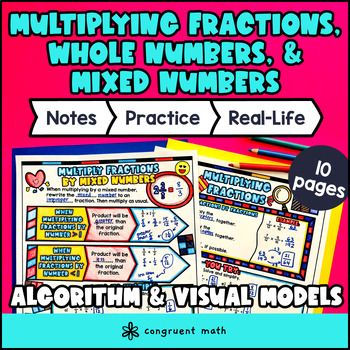Want more ideas and freebies?
Get my free resource library with digital & print activities—plus tips over email.
Join for Free Resources →
$4.25
Ever wondered how to teach multiplying fractions in an engaging way to your 5th or 6th-grade students?
In this lesson plan, students will learn about multiplying fractions, whole numbers, and mixed numbers using visual models, tiling, and algorithms. Through artistic, interactive guided notes, checks for understanding, a color-by-code activity, and a maze worksheet, students will gain a comprehensive understanding of fraction multiplication.
The lesson concludes with a real-life example that explores how multiplying fractions is used in everyday situations like tiling and measurement.

$4.25
After this lesson, students will be able to:
Before this lesson, students should be familiar with:
As a hook, ask students if they have ever shared a pizza or a chocolate bar with friends and wondered how you could figure out exactly how much each person gets if you multiply portions. Refer to the real-life application page at the end of the guided notes for ideas on how multiplying fractions is used in everyday situations, such as cooking or dividing items fairly.
Use the first page of the guided notes to introduce multiplying fractions by whole numbers and multiplying fractions by fractions. Highlight key points such as understanding the numerator and denominator roles in the product and illustrates the multiplication process. Incorporate the embedded checks for understanding to gauge student comprehension before moving on. Refer to the FAQ below for detailed guidance on explaining the model, common student misconceptions (like confusing multiplication with addition), and ways to clarify those points.
Use the second page of the guided notes to introduce multiplying fractions by fractions and mixed numbers. Emphasize converting mixed numbers to improper fractions and simplifying the product to a mixed number if appropriate. Use the integrated comprehension checks to determine which students may need more support.
Then, use the bottom half of the second page to walk through how to represent the fractions using visual models and tiling and how to partition the model to find the product. Guide students through sketching the tiled models step-by-step and interpreting how multiplying the numerators and denominators corresponds to the shaded areas in the visual. Refer to the FAQ below for advice on presenting these concepts clearly and addressing typical questions like why denominators multiply instead of add.
Based on student responses during these guided notes sections, reteach any concepts that students find challenging. For example, revisit the area model if students struggle to visualize the multiplication or break down the fraction and mixed number conversion process for those needing additional support. If your class has a wide range of proficiency levels, consider pulling small groups of students for targeted reteaching while allowing advanced students to begin the practice exercises early, reinforcing their understanding independently.
Have students practice multiplying fractions by whole numbers, fractions, and mixed numbers using the maze activity included (page 4). Walk around to answer student questions.
Fast finishers can start the color by number (page 5) practice worksheet for extra practice. You can assign it as homework for the remainder of the class.
Bring the class back together, and introduce the concept of using fraction multiplication in real-life situations such as cooking, where ingredients need to be adjusted by multiplying fractions and whole numbers. Discuss how tiling a floor or wall can involve calculating the amount of material needed when using fractional quantities. Refer to the FAQ for more ideas on how to teach it!
If you’re looking for digital practice for multiplying fractions by whole numbers and fractions, try my Pixel Art activities in Google Sheets. Every answer is automatically checked, and correct answers unlock parts of a mystery picture. It’s incredibly fun, and a powerful tool for differentiation.
Here’s 3 activities to explore:
A fun, no-prep way to practice equivalent fractions and related fraction skills is Doodle Math — they’re a fresh take on color by number or color by code. It includes multiple levels of practice, perfect for a review day or sub plan.
Here’s 1 activity to explore:
Get my free resource library with digital & print activities—plus tips over email.
Join for Free Resources →